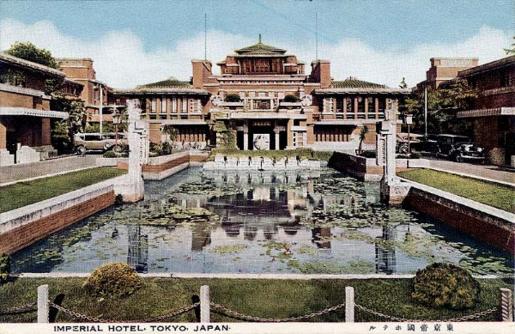Did Frank Lloyd Wright’s Design for the Imperial Hotel in Tokyo Keep it From Being Destroyed in an Earthquake?
Here is the latest in a series of examinations into urban legends related to architecture and whether they are true or false. Click here to view an archive of the architecture urban legends featured so far.
ARCHITECTURE URBAN LEGEND: Frank Lloyd Wright’s design for Imperial Hotel in Tokyo led to the Hotel being unaffected by the 1923 Great Tokyo Earthquake.
The second Imperial Hotel (the first one was destroyed by fire in 1919) was designed by legendary architect Frank Lloyd Wright. Wright had long been fascinated by Japanese culture and he envisioned (and designed) the hotel as a hybrid of Japanese and Western architecture.

Earthquakes have long been a danger in Japan, and Wright decided to design the hotel to protect the building from being damaged in an earthquake.
This has led to a legend that has been passed around a number of websites under the heading of CONFIDENCE (where stories about famous people being confident are shared). The citation is to a January 1993 issue of Bits and Pieces magazine (the magazine that motivates people!).
Frank Lloyd Wright is among the most innovative architects this county ever produced. But his fame wasn’t limited to the United States. About 70 years ago, Japan asked Wright to design a hotel for Tokyo that would be capable of surviving an earthquake. When the architect visited Japan to see where the Imperial Hotel was to be built, he was appalled to find only about eight feet of earth on the site. Beneath that was 60 feet of soft mud that slipped and shook like jelly. Every test hole he dug filled up immediately with water. A lesser man probably would have given up right there. But not Frank Lloyd Wright. Since the hotel was going to rest on fluid ground, Wright decided to build it like a ship. Instead of trying to keep the structure from moving during a quake, he incorporated features that would allow the hotel to ride out the shock without damage. Supports were sunk into the soft mud, and sections of the foundation were cantilevered from the supports. The rooms were built in sections like a train and hinged together. Water pipes and electric lines, usually the first to shear off in an earthquake, were hung in vertical shafts where they could sway freely if necessary. Wright knew that the major cause of destruction after an earthquake was fire, because water lines are apt to be broken in the ground and there is no way to put the fire out. So he insisted on a large outdoor pool in the courtyard of his hotel, “just in case.”
On September 1, 1923, Tokyo had the greatest earthquake in its history. There were fires all over the city, and 140,000 people died. Back in the U.S., news reports were slow coming in. One newspaper wanted to print the story that the Imperial Hotel had been destroyed, as rumor had it. But when a reporter called Frank Lloyd Wright, he said that they could print the story if they wished, but they would only have to retract it later. He knew the hotel would not collapse.
Shortly afterward, Wright got a telegram from Japan. The Imperial Hotel was completely undamaged. Not only that — it had provided a home for hundreds of people. And when fires that raged all around the hotel threatened to spread, bucket brigades kept the structure wetted down with water from the hotel’s pool. The Imperial Hotel isn’t there anymore. It was finally torn down in the 1960s to be replaced by a more modern structure.
Baron Kihachiro Okura did, indeed, sent Wright a telegram stating:
Hotel stands undamaged as monument to your genius Congratulations
And it was this that Wright, naturally enough, shared with reporters (it was not like lots of other people had any direct information to contradict him). And it was this telegram that spread the “the hotel was unaffected by the earthquake” legend.
Is it true?
It was not.
First of all, let me note that a lot of Wright’s ideas turned out to be excellent, particularly in terms of the 1923 earthquake. The idea about the wires and pipes was ingenious. And the water outside worked exactly as planned.
However, pieces of the building’s stonework did fall off, the center of the building slumped and more than one of the floors bulged. According to a great study on the earthquake’s effect on the Imperial Hotel, Robert King Reitherman noted:
The Imperial Hotel experienced some non-structural and structual damage in the 1923 earthquake: the dining room floor bulged and required cutting and shimming of concrete columns to re-level it, and fans, kitchen equipment, lights, partions and other similar non-structural items were damaged. The insurance companies’ damage rating system used a five point scale. The Imperial Hotel was listed in the category of second-best performance, or light damage. There were other large buildings which were rated in the first category.
But beyond that, besides just the simple “the claim was that it was completely undamaged and it was damaged” part, there is something even more important to note about the hotel design. The “float like a battleship” idea Wright had with the mud? Well, that might have worked if it ever came to that, but that design also led to the building sinking in the mud, thereby messing with the foundation of the building to the point where it was not in good shape when it was replaced in the late 1960s. A new highrise Imperial Hotel debuted in 1968 and remains there to this day. In fact, Reitherman also notes that the mud actually CONDUCTED the seismic waves, so the fact that the building sunk into the mud actually hurt the building MORE. In other words, if not for Wright’s battleship idea, the building’s columns would have been affected LESS and the building might not have been in a serious state of disrepair by the 1960s. It is worth noting, though, that the relative small size of the hotel was a bigger reason for renovation than its condition (they wanted to utilize the space to build up).
Still, as Reitherman also notes in his work, Wright did have a lot of good ideas (including stuff that was truly state-of-the art, like seismic separation joints, located about every 20 meters along the building), he just did not make some perfect earthquake resistant building, which the legends say that he did.
The legend is…
STATUS: False Enough for a False
Thanks again to Reitherman and his fascinating paper, Frank Lloyd Wright’s Imperial Hotel: A Seismic Re-Evaluation.
Feel free (heck, I implore you!) to write in with your suggestions for future installments! My e-mail address is bcronin@legendsrevealed.com.





